Painted Dog population falls 99%, but community efforts could save species
Painted Dog population falls 99%, but community efforts could save species
An interview with Peter Blinston of Painted Dog Conservation
Rhett A. Butler, mongabay.com
September 29, 2008
The painted dog, or African wild dog, was once found widely across Africa but relentless persecution by humans, coupled with habitat loss and spread of disease from domestic dogs, has driven the population down from 500,000 to less than 5,000 over the past century. The species is now listed as endangered by the IUCN. While the outlook is not good in many countries, there are emerging signs of hope, particularly in Zimbabwe where the efforts of a community-based conservation project has nearly doubled the population of the dog to 700 individuals.
The effort, led by Painted Dog Conservation (PDC), relies on advanced technology and community involvement to reduce threats to the species while simultaneously creating rural livelihoods and educational opportunities in a country where political turmoil has made life difficult for many people. PDC’s strategy includes education programs, research to better understand threats to the species, and anti-poaching patrols to clear snares which are then turned into artwork by local artisans and sold to generate income for communities. PDC also offers HIV-AIDS testing and treatment to conservation workers and is helping establish HIV programs in some of the country’s most desperate communities.
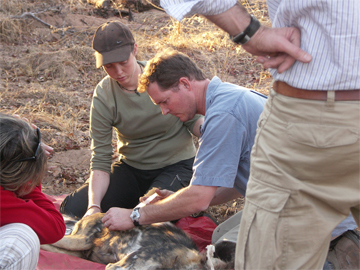 Peter Blinston |
In an interview ahead of an upcoming appearance in the U.S., Peter Blinston, PDC’s manager, spoke about his organization’s work and its efforts to combine conservation with community development. PDC is partially supported by the Wildlife Conservation Network (WCN), an innovative group that uses a venture capital model to protect some of the world's most endangered species. WCN will be hosting Blinston at its upcoming Wildlife Conservation Expo in San Francisco, California on October 4th. Expo attendees will be able to meet Blinston and learn more about PDC firsthand. The event, which is open to the public and costs $25-50 per person, also features 16 other conservationists working to protect wildlife around the world.
AN INTERVIEW WITH PETER BLINSTON OF PAINTED DOG CONSERVATION
Mongabay: What is your background and how did you get interested in working on the Painted dog?
Peter Blinston: My background and past experiences are varied. I actually have a degree in Operations Management and worked on cruise ships such as the QE2. However my passion, since I was 8 years old has been wildlife and it was the painted dogs that got me hooked, as I watched a documentary about the dogs when I was 8 years old, called Solo. It was made by Hugo van Lawick and Jane Goodall.
Mongabay: How many people are involved with the Painted Dog Conservation Project in Zimbabwe?
Peter Blinston: We employ 67 local staff.
Mongabay: Why are Painted dogs endangered and what are presently the greatest threats to them?
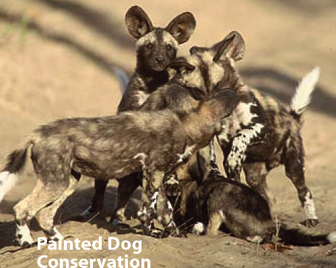 Painted dogs, courtesy of PDC |
Peter Blinston: They are endangered due to persecution from man. Much as the wolf has been persecuted across Europe and North America, so the painted dog was taken to the brink of extinction (1% of the former population survive today) following the colonization of Africa. Bounties were placed on all predators and there was a particular antipathy towards the distant cousin of our favorite pets. Today the biggest threat in our area is poaching for bush meat using wire snares. On a pan-African basis the biggest threat is probably competition for space, though ignorance and an associated lack of understanding or care is still a serious problem.
Mongabay: On your web site you mention medicinal uses of dogs. Could you elaborate on this? Is there a belief that wild dogs have healing properties?
Peter Blinston: Not so much healing properties though I did get approached once by a guy who had travelled from Cape Town searching for teeth, as he was told that this was the only cure for his mothers ills!!! In our area the teeth and organs such as heart are fed to domestic dogs and eaten by hunters so that they acquire the hunting powers of the painted dog.
Mongabay: Interaction with domestic dogs can be a vector for disease transmission for Painted dogs in some areas. Do you have a vaccination or sterilization program or are you otherwise seeking to reduce the number of domestic dogs in sensitive areas?
 Peter Blinston |
Peter Blinston: Actually its not that big an issue, at least in our area. There is not so much interaction between the species though there are a lot of domestic dogs around. Zimbabwe did have a vaccination program for domestic dogs, however that has all but collapsed now. We have had one reported case of rabies in the Hwange region in 10 years.
Mongabay: What are some other measures you are employing to help protect the Painted dog?
Peter Blinston: Our anti poaching units are our front line of protection. They clear thousands of snares a year in an effort to protect the dogs and the wildlife they coexist with. We also fit VHF collars that have a metal plate incorporated into them, which gives the dogs some protection if they get caught in a snare. Road kills are also common so we had warning signs put up along the main roads in the area.
Mongabay: What are the biggest challenges of your work?
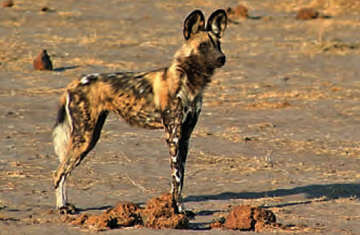 Painted dog, courtesy of WCN |
Peter Blinston: The chronic economic situation in Zimbabwe presents the biggest challenge to us. It is driving the poaching for one thing and it has reduced the value of a human life let alone that of wildlife. Acquiring even basic commodities and keeping the various programs going presents constant logistical hurdles to over come and means we are often in a state of crisis management.
Mongabay: HIV-AIDS is prevalent in Zimbabwe. How does this impact the Painted Dog Conservation Project?
Peter Blinston: We started out with developing our own HIV / AIDS workplace agreement and Charlie Knowles of WCN got involved at that stage by sending a doctor from South Africa to test and council our staff. It was only then that we really realized the extent of the problem in terms of the number of affected staff. We are working with communities to help them develop nutritional gardens in an effort to help them fight HIV / AIDS
Mongabay: Does the political situation in Zimbabwe impact your efforts?
Peter Blinston: It affects us in terms of the economy as mentioned above but not in terms of political agendas or anything like that. We had to suspend our programs for a couple of weeks around the re-run election but that was all. We have had our moments in the past but we have a good board of trustees who I can call on to “ride shotgun” for me if required. We are well established and highly regarded, so know one tries to interfere. I have a bit of a reputation (apparently) for not being easily intimidated!!
Mongabay: Is there much tourism in the places you work? Does this help or hurt Painted dog conservation efforts?
Peter Blinston: There is very little tourism which is devastating for the region and the country as a whole. We rely a lot on sightings of the dogs from tourists and so we get very few, thus it is difficult at times to know exactly what is going on on the ground in terms of the populations.
Mongabay: How can people in places like the U.S. help Painted dog conservation?
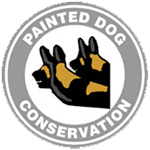
|
Peter Blinston: We would sink like a stone without the financial support we get from the USA in particular. However its awareness and empathy that is needed in equally large doses if the dogs are going to make it.
Mongabay: Do you have any tips for aspiring field conservationists?
Peter Blinston: Study hard and become a lawyer or doctor…. something more sensible anyway!! If that doesn’t work then listen to your heart. Conservation for me is about passion, a deep commitment to something you care passionately for.
Related
Group takes “venture capital” approach to conservation
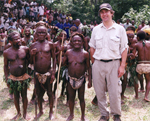
|
(09/16/2008) An innovative group is using a venture capital model to save some of the world’s most endangered species, while at the same time working to ensure that local communities benefit from conservation efforts. The Wildlife Conservation Network (WCN), an organization based in Los Altos, California, works to protect threatened species by focusing on what it terms “conservation entrepreneurs” — people who are passionate about saving wildlife and have creative ideas for dong so. After a rigorous review process to identify and select projects that will have the greatest impact on conservation in developing countries, WCN provides the conservationist with fund-raising and back-office support, technology, and access to its network of people and resources.














